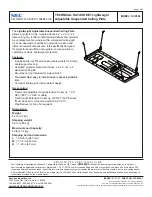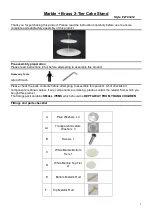
Observe the usage instructions
and install in a visible position
at the charging bay. Only trained
personnel may perform work on
batteries.
Safety goggles and protective
clothing must be worn when wor-
king on batteries. Observe the
accident-prevention regulations
as well as EN 50272-3 and EN
50110-1.
Smoking is prohibited. There
must be no naked flames,
embers or sparks in the vicinity of
the battery, as this poses a risk
of explosion and a fire hazard.
Keep children away from bat-
teries!
Rinse eyes or skin splashed with
acid using plenty of clean water.
Then consult a doctor immedia-
tely. Wash clothing contaminated
with acid with plenty of water.
Electrolyte is highly corrosive.
Contact with electrolyte is not
possible during normal operation.
Risk of explosion and fire, avoid
short circuits!
Only use approved lifting and
transportation equipment, e.g.
lifting gear in accordance with
VDI 3616. Lifting hooks must
not cause any damage to cells,
connectors or connecting cables.
Dangerous electrical voltage.
Attention: Metallic parts of the battery cells
are always live. Therefore, no foreign objects
or tools may be placed on the batteries.
Warranty claims will no longer be valid in
the event of non-observance of the usage
instructions, repairs using non-original
spare parts or unauthorised intervention.
1. Start-up
The battery must be checked to ensure that
it is in mechanically perfect condition. The
installation area must be cleaned prior to
installation.
Only interconnect battery blocks with the
same charge state (same open-circuit vol-
tage, tolerance as per the following table).
Never power electrical consumers via a part
of the battery.
The battery terminal end must be connected
with the correct polarity and with reliable
contact. Otherwise, the batteries, the vehic-
le or the charging device may be destroyed.
Following assembly, the terminals must be
greased to protect against corrosion. The
battery must be recharged as per Item.
Tightening torque for pole screws on the
terminal ends and connectors:
2. Operation
The regulations in accordance with Standard
EN 50272 – Safety requirements for
secondary batteries and battery installations
– Part 3 apply for the operation of vehic-
le batteries. Traction batteries for electric
vehicles.
2.1 Discharging
The battery valves must not be closed or
covered. Electrical connections (e. g. plug
connectors) must only be opened or closed
when in de-energised state.
In order to achieve an optimal service life,
discharge of over 60 % of the rated capacity
should be avoided. Discharge of over 80%
of the rated capacity is a deep discharge
and is not permissible. These significantly
reduce the service life of the battery. Only
those discharge state indicators that have
been approved by the battery manufacturer
may be used.
Discharged batteries must be charged
immediately and must not remain in dischar-
ged state. This also applies to batteries in a
state of deep discharge. Otherwise, the
service life of the battery will be significantly
reduced. The battery may freeze when in
discharged state.
2.2 Charging
Batteries must only be charged with direct
current. The charging methods in accor-
dance with DIN 41773-1 must only be
applied in the modification approved by the
manufacturer HOPPECKE. Therefore, only
those chargers that have been approved by
the battery manufacturer HOPPECKE may
be used. In order to prevent overloading
of the electrical cables and contacts and
impermissible gas formation, the battery
must only be connected to the allocated
charger that is permissible for the respective
battery size.
Usage instructions
trak
®
bloc
Lead-acid batteries with closed grid plate cells (trak
®
bloc)
Rated values
1. Rated capacity:
see type plate
2. Rated voltage:
see type plate
3. Discharge current:
C5/5 h or C20/20 h
4. Rated temperature:
30 °C
trak
®
bloc batteries are closed batteries with suspended electrolytes that
must not be topped
up with water
for the entire duration of the service life. Pressure relief valves are used as
sealing plugs. These valves stop oxygen getting into the cells and drain off any excess charging
gases. The valves must not be removed. During operation, the same safety requirements apply
to the closed batteries as to batteries with liquid electrolyte in order to prevent electric shock
and explosion of the electrolytic charging gases and to avoid the risk of corrosive electrolytes
if the cell container is destroyed.
Rated
voltage
module
[V]
6
12
Maximum deviation
from mean value -
U
bloc
[V]
± 0,035
± 0,049
Cone terminal
Screw terminal M6/M8
Flat terminal M6
8 ± 1 Nm
20 ± 1 Nm
6 ± 1 Nm




















